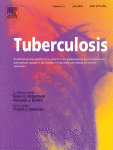Ver ítem
- xmlui.general.dspace_homeCentros e Institutos de InvestigaciónCICVyA. Centro de Investigación en Ciencias Veterinarias y AgronómicasInstituto de BiotecnologíaArtículos científicosxmlui.ArtifactBrowser.ItemViewer.trail
- Inicio
- Centros e Institutos de Investigación
- CICVyA. Centro de Investigación en Ciencias Veterinarias y Agronómicas
- Instituto de Biotecnología
- Artículos científicos
- Ver ítem
Mycobacterial MCE proteins as transporters that control lipid homeostasis of the cell wall
Resumen
Mammalian cell entry (mce) genes are not only present in genomes of pathogenic mycobacteria, including Mycobacterium tuberculosis (the causative agent of tuberculosis), but also in saprophytic and opportunistic mycobacterial species. MCE are conserved cell-wall proteins encoded by mce operons, which maintain an identical structure in all mycobacteria: two yrbE genes (A and B) followed by six mce genes (A, B, C, D, E and F). Although these proteins are
[ver mas...]
Mammalian cell entry (mce) genes are not only present in genomes of pathogenic mycobacteria, including Mycobacterium tuberculosis (the causative agent of tuberculosis), but also in saprophytic and opportunistic mycobacterial species. MCE are conserved cell-wall proteins encoded by mce operons, which maintain an identical structure in all mycobacteria: two yrbE genes (A and B) followed by six mce genes (A, B, C, D, E and F). Although these proteins are known to participate in the virulence of pathogenic mycobacteria, the presence of the operons in nonpathogenic mycobacteria and other bacteria indicates that they play another role apart from host cell invasion. In this respect, more recent studies suggest that they are functionally similar to ABC transporters and form part of lipid transporters in Actinobacteria.
To date, most reviews on mce operons in the literature discuss their role in virulence. However, according to data from transcriptional studies, mce genes, particularly the mce1 and mce4 operons, modify their expression according to the carbon source and upon hypoxia, starvation, surface stress and oxidative stress; which suggests a role of MCE proteins in the response of Mycobacteria to external stressors. In addition to these data, this review also summarizes the studies demonstrating the role of MCE proteins as lipid transporters as well as the relevance of their transport function in the interaction of pathogenic Mycobacteria with the hosts. Altogether, the evidence to date would indicate that MCE proteins participate in the response to the stress conditions that mycobacteria encounter during infection, by participating in the cell wall remodelling and possibly contributing to lipid homeostasis.
[Cerrar]

Fuente
Tuberculosis 132 : 102162 (January 2022)
Fecha
2022-01
Editorial
Elsevier
ISSN
1472-9792
Documentos Relacionados
Formato
pdf
Tipo de documento
artículo
Proyectos
(ver más)
INTA/2019-PD-E5-I103-001/2019-PD-E5-I103-001/AR./Desarrollo de tecnologías diagnósticas y estudios epidemiológicos para el control de enfermedades que afectan la producción animal y la salud pública
INTA/2019-PD-E5-I105-001/2019-PD-E5-I105-001/AR./Patógenos animales: su interacción con el hospedador y el medio ambiente. Impacto en productividad, ecosistemas, sanidad animal y salud pública en el marco “Una Salud”
Palabras Claves
Derechos de acceso
Restringido
 Excepto donde se diga explicitamente, este item se publica bajo la siguiente descripción: Creative Commons Attribution-NonCommercial-ShareAlike 2.5 Unported (CC BY-NC-SA 2.5)
Excepto donde se diga explicitamente, este item se publica bajo la siguiente descripción: Creative Commons Attribution-NonCommercial-ShareAlike 2.5 Unported (CC BY-NC-SA 2.5)

